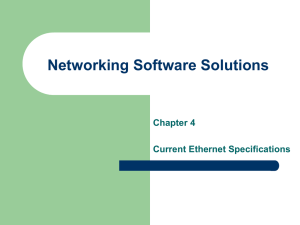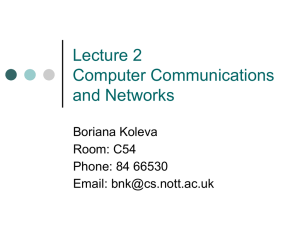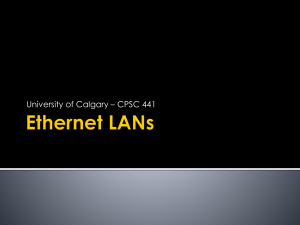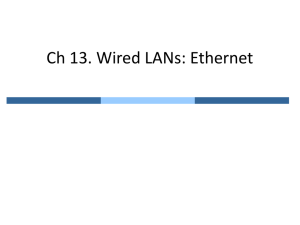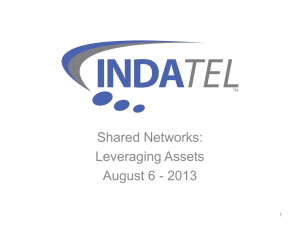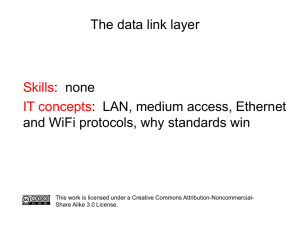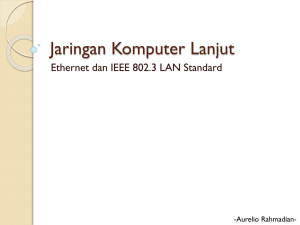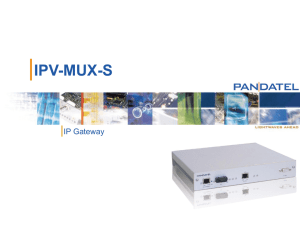Carrier
advertisement
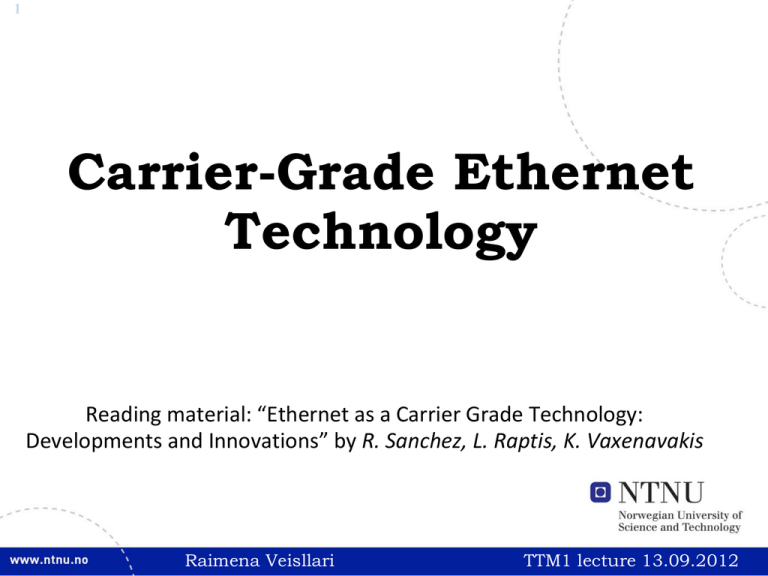
1 Carrier-Grade Ethernet Technology Reading material: “Ethernet as a Carrier Grade Technology: Developments and Innovations” by R. Sanchez, L. Raptis, K. Vaxenavakis Raimena Veisllari TTM1 lecture 13.09.2012 2 Outline • A short history of Ethernet • Reasons and Challenges for the Carrier Ethernet development • Carrier Ethernet characteristics – Scalability through VLAN hierarchy – Traffic Engineering (TE) – Operation, Administration and Management (OAM) • Deployment case study 3 The native Ethernet 1973 - Metcalfe and Boggs (Xerox) Shared medium access protocol CSMA/CD, IEEE 802.3 (1980) Coaxial Cable (”Ether”) based network Thick Ethernet (10Base5) Thin Ethernet (10Base2) Twisted Pair (full-duplex communication, Base-T), Fiber (Base-X) Repeaters and Hubs – one collision domain Bridges and Switches – one broadcast domain 4 The native Ethernet 7 octets Preamble for synchronization Indication of SFD (10101011) start of MAC frames 48 bit destination and source addresses EtherType (upper layer protocol, e.g. IP) 5 Main characteristics CSMA/CD (Do we still need it in switched Ethernet?) Simplicity (plug n’play) and cost effective The switching logic (self-configuration) Listen, Learn and Forward Redundancy through xSTP VLAN known as a broadcast domain Connection-less (single hop) 6 Why did Ethernet “win” in the customer domain? • There are LOTS of LAN protocols • Price! • • • • • Performance Availability Ease of use Scalability …. 7 Why Carrier Ethernet ? • SP infrastrucure based on legacy circuit-switched SDH/SONET, ATM, frame relay etc. • Ethernet as the technology of choice in the customer domain (85% of all networks and 95% of all LANs) • Internet is packet-switched • Eliminate potential internetworking problems • High bandwidth with simplicity and low cost 8 Carrier Ethernet Definition The MEF1) has defined Carrier Ethernet as “an ubiquitous, standardized, carrier-class Service and Network defined by five attributes that distinguish Carrier Ethernet from familiar LAN based Ethernet” Standardized services Scalability Reliability QoS Service Management 1) http://metroethernetforum.org/index.php 9 Carrier Ethernet Challenges Moving Ethernet from the LAN to the carrier network brings out requirements/challenges: 1. Scalability – – Support for 10exp6 customers of an SP Evolving the VLAN-tagging standards 2. Protection (Reliability and Resiliency) – – – Achieve the required 50ms recovery time Problems with xSTP recovery time Other protocols required 10 Carrier Ethernet Challenges 3. Quality of Service – Hard QoS comparable with the guaranteed service from existing leased lines 4. Service Management – – – Service provisioning based on SLAs Service Monitoring Troubleshooting 5. TDM support – Inter-working with existing technologies (leverage the customer-driven investment) 11 Standardization Milestones 12 Scalability: Virtual LANs • IEEE 802.1Q Virtual LAN: • • • • • Management, security and scalability reasons. Layer3 between VLANs 4094 available VLANs not enough for an SP! Transparency problem within the SP backbone network! A failure in the customer’s domain still affects the spanning-tree of the provider’s core (transport) network 13 Q-in-Q Virtual LAN • IEEE 802.1ad Provider Bridges • Add a new S-VID to the frame (VLAN stacking) • Use the same MAC addresses through all the networks • A maximum of 4094 VLANs is a limitation for the provider! 14 MAC-in-MAC Virtual LAN • IEEE 802.1ah Provider Backbone Bridges (PBB) • Add a backbone MAC header (encapsulate the customers frame) 15 VLAN hierarchy evolution - MAC-in-MAC header encapsulation - 24 bit I-SID - Dedicated set of MAC addresses 16 IEEE 802.1ah (PBB) Provider Backbone Bridges provides: 1. 24 bit I-SID identifying the service in the SP => 16exp6 services 2. Total separation of the customer and SP networks The MAC header is added at the edge of the SP The backbone B-VID used for traffic engineering, ”zone”separation SP control frames are independent from the customer’s ones 3. Tunneling Ref: «IEEE 802.1ah Update” Paul Bottorff, Editor 802.1ah 17 IEEE 802.1ah (PBB) Ref: «IEEE 802.1ah Update” Paul Bottorff, Editor 802.1ah 18 IEEE 802.1ah (PBB) An I-SID uniquely identifies an S-VLAN with the Backbone The I-SID to/from S-VID mapping is provisioned when a new service instance is created B-VID : Separate the providers ID space : Many S-VLANs carried in a single B-VLAN Ref: «IEEE 802.1ah Update” Paul Bottorff, Editor 802.1ah 19 Ethernet Services • MEF defines the services as Ethernet Virtual Connections (EVC): 1. Point-to-point E-LINE 2. Point-to-Multipoint E-Tree 3. Multipoint-to-Multipoint E-LAN 1.1 Ethernet Private Leased Lines (EPL) – dedicated bandwidth 1.2 Ethernet Virtual Leased Lines (EVPL) – shared bandwidth 20 PBB-Traffic Engineering PBB-TE 802.1Qay introduced connection-oriented forwarding mode and Ethernet tunnels: Forwarding is not based on the MAC learning mechanism but provided by the OAM plane Turning off xSTP Deterministic service delivery, QoS Resiliency OAM requirements 21 Carrier network with PBT 22 Operation, Administration and Maintenance (OAM) Important building block toward carrier services Ethernet, multiple working/standardization bodies. IEEE 802.1ag and ITU-T Y.1731: Fault detection : Continuity Check Messages Fault verification : Loopback and reply messages Fault Isolation : Linktrace and Reply messages ITU-T Y.1731 Fault notification through Alarm Indication Signal Performance monitoring Frame Loss Ratio Frame Delay Frame Delay Variation 23 OAM example 24 Carrier Ethernet: What we looked into? Traffic Engineering OAM VLAN standards 1) http://metroethernetforum.org/index.php 25 Conclusions • Its simplicity and cost-effectiveness makes Ethernet a desirable technology for the NGN carrier networks – Can Ethernet still be considered ”simple” after the discussed changes??? • Native Ethernet is lacking capabilities for MAN and WAN environment. • PBB, PBB-TE and OAM aim to enhance Ethernet and provide the required carrier-grade services as from SONET/SDH, ATM and MPLS. • The competing carrier technologies OTN and IP/MPLS will be discussed in the course as well! • Resiliency? • Work in progress! 26 For further leisure reading • Examples taken from “The road to Carrier-grade Ethernet” K. Fouli, M. Maier http://ieeexplore.ieee.org/stamp/stamp.jsp?tp=&arnumber =4804387 • Metro Ethernet Forum MEF http://metroethernetforum.org/index.php 27 IP over Optical (1) Basic requirements: • High capacity optical layer network • Support high utilization of resources • Support high granularity • Support quality needed for strict real-time services • Support variable length packets 28 IP over Optical (2) • Legacy technology, e.g. SDH/SONET network infrastructures have provided a guaranteed level of performance and reliability for voice calls and leased lines. • Existing networks have been designed for telephony : static traffic patterns • Inefficient in handling the new traffic patterns that are dominated by data services. Increased traffic demands (e.g. from broadband home users/businesses and new services) => Fat pipes needed. 29 IP over Optical (3) ”IP everywhere” and development in optical technology => Focus on simplifications: What does the network look like? 30 IP over Optical (4) 31 IP over Optical (5) • Traffic bypassing intermediate IP routers == Less load on routers – smaller and cheaper • In meshed networks: Used to directly connect node pairs with high traffic load between them. Ref [1] 32 Optical cross-connect example • Wavelength switching done all-optically e.g. (transit traffic) • Locally destined wavelengths dropped/added (processed electronically)
